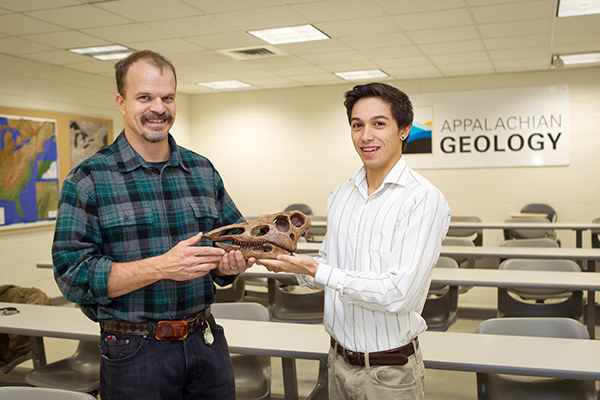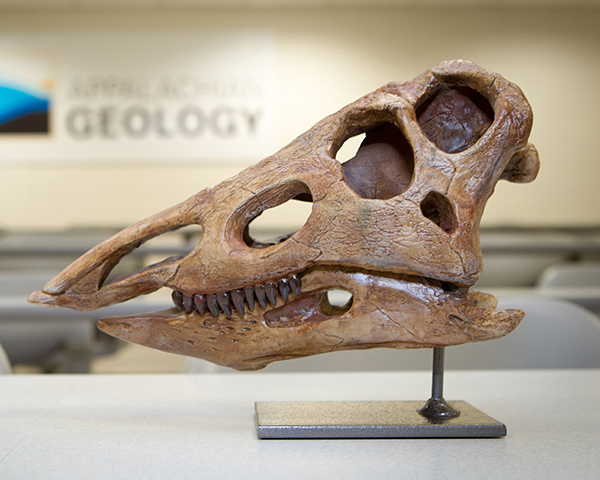BOONE—Senior geology major Haviv Avrahami was a winner on two counts at the recent 75th annual meeting of the Society of Vertebrate Paleontology held in Dallas.
In addition to being invited to present a talk on his research, something undergraduates seldom get to do, the Appalachian State University student, who is concentrating in paleontology, won $1,000 worth of high-end fossil replicas from Triebold Paleontology, a vendor at the conference. He has donated one to the Department of Geology’s McKinney Geology Teaching Museum located in Rankin Hall.
Avrahami selected a replica of a Desmatosuchus skull to add to the museum. The reptile is from the Late Triassic period. The true-to-life replica will allow students and others to closely study the fossil that would otherwise be too fragile or unavailable for research. “It’s frowned upon within the paleontological community for individuals to possess museum-quality fossils,” Avrahami explained.
“A lot of time when you are in a museum what you are seeing is a cast because it can be destructive to try and mount the actual specimen for display,” explained Professor Andrew B. Heckert.
Avrahami became interested in dinosaur paleontology while living in California. While his mother worked on her Ph.D. at UCLA, he spent time in the library reading science books. His love of the field was further fed by movies like “Jurassic Park” and the character Ross on the TV series “Friends,” who was a paleontologist.
In summer 2014, Avrahami participated in a field course in Utah with the N.C. Museum of Natural Sciences. While there, he found what’s believed to be a new species of dinosaur, Heckert said. The new species, now located at the museum, is a basal ornithopod that is closely related toThescelosaurus, a small, plant-eating dinosaur from the Late Cretaceous Period.
Avrahami helped recover about fossil specimens of various sizes from the Utah site, including parts of the skull, the tibia and other long bones from the new species. “We really hit the jackpot when we found well-preserved parts of the skull. This is one of the most exceptionally preserved specimens of this type of dinosaur ever discovered anywhere in the world,” he said.
While at the Society of Vertebrate Paleontology meeting, Avrahami gave a talk on benefits of using paint sieves for screening and washing sediment to recover microfossils rather than the traditional but bulky screen boxes. The paint sieves are more economical and lightweight and easily transportable in the field. The research, conducted with Heckert, was supported by a University Research Council grant. Avrahami and Heckert’s travel to the SVP meeting was supported by Appalachian’s Office of Student Research.
Avrahami hopes to further study the dinosaur as part of his master’s degree work at N.C. State University after graduating from Appalachian in May 2016. He ultimately plans to pursue a Ph.D. with the goal of working in a museum.
About Appalachian State University
As a premier public institution, Appalachian State University prepares students to lead purposeful lives. App State is one of 17 campuses in the University of North Carolina System, with a national reputation for innovative teaching and opening access to a high-quality, cost-effective education. The university enrolls more than 21,000 students, has a low student-to-faculty ratio and offers more than 150 undergraduate and 80 graduate majors at its Boone and Hickory campuses and through App State Online. Learn more at https://www.appstate.edu.
What do you think?
Share your feedback on this story.













